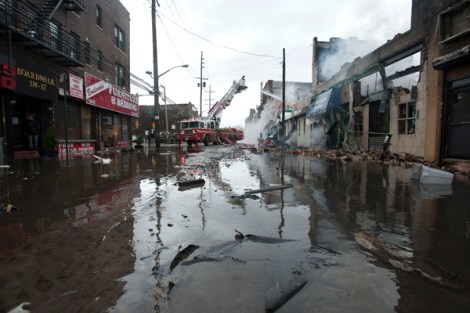
Reuters / Keith BedfordDamage in the Rockaways.
Earlier this week, The New York Times examined how some of New York City’s poorest residents ended up in what under different circumstances might be highly sought-after real estate: land right by the shore.
New York started building housing projects on the waterfront because that’s where its poorest citizens happened to live. It continued because that’s where space was most readily available. Finally, it built them there because that’s where its projects already were.
The case of the Rockaways, the spit of land on the southeastern edge of the city, is slightly different. The Rockaways are home to a disproportionately high number of poor people because of Robert Moses, the despotic city planner whose mid-century efforts to reshape New York City were largely successful.
Never one for nostalgia, Moses saw the Rockaways as both a symbol of the past and a justification for his own aggressive approach to urban renewal, to building what he envisioned as the city of the future. “Such beaches as the Rockaways and those on Long Island and Coney Island lend themselves to summer exploitation, to honky-tonk catchpenny amusement resorts, shacks built without reference to health, sanitation, safety and decent living,” he said, making his case for refashioning the old summer resorts into year-round residential communities.
What is more, the Rockaways had plenty of land that the city could buy cheaply, or simply seize under its newly increased powers of eminent domain, swaths big enough to accommodate the enormous public-housing towers Moses intended to build as part of his “Rockaway Improvement Plan.” Though only a tiny fraction of the population of Queens lived in the Rockaways, it would soon contain more than half of its public housing.
The old summer bungalows that weren’t bulldozed in the process were repurposed as year-round housing for those uprooted by Moses’ urban renewal — derided as “negro removal,” by the writer James Baldwin — across the city.
There’s some irony in this: Many Sandy-related deaths occurred in small, low-lying structures, while Moses’ much-derided highrises turned out to be safer places to ride out the storm.
Moses took the same tack throughout the city, congregating low-income residents far from population centers. Later efforts to reverse the strategy often met with public opposition, and so there still remains a heavy density of low-income housing in areas particularly vulnerable to the ocean, including at the lower end of Manhattan.
Shortly after Sandy hit, we noted how it apparently put low-income residents at higher risk. Now, thanks to this set of maps from WNYC, we can see how Sandy’s flooded areas compare to variations in New York City incomes. (Flooding wasn’t the only damage, of course — power outages and water restrictions often had a longer, deeper effect.)
[protected-iframe id=”c5eab94678093dbf69e78df829b3be63-5104299-30178935″ info=”http://project.wnyc.org/flooding-sandy-new/index.html” width=”470″ height=”500″]
[protected-iframe id=”f9877ca6915cb6a08a81e12c39f2b2fe-5104299-30178935″ info=”http://project.wnyc.org/acs2011/income.html?layer=0#11.00/40.7004/-73.9271″ width=”470″ height=”500″]
Note the Rockaways, along the ocean in the southeastern part of the city. In the income map, there’s a splash of light red. In the flooding map, it, like so much else, is solidly blue.


